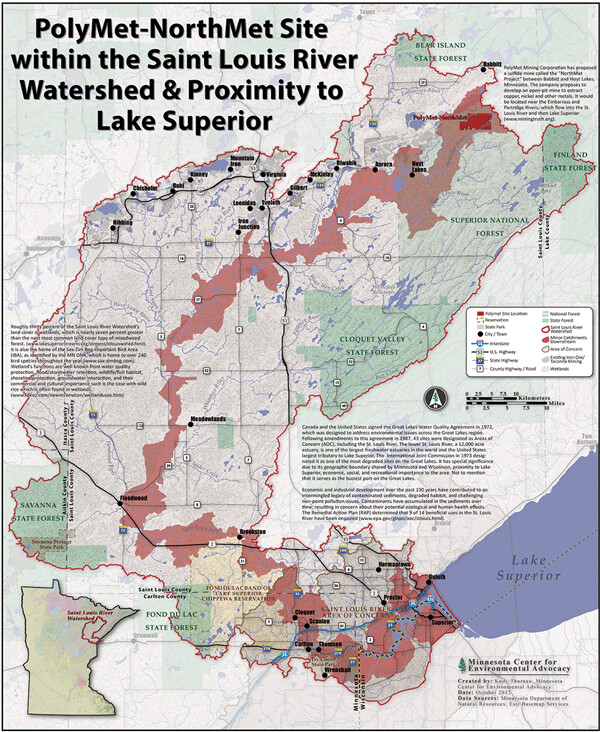PolyMet—The Toxic Trojan Horse

The process to approve PolyMet, which would be the first ever copper-nickel sulfide mine in Minnesota, rolls on. The Minnesota Department of Natural Resources (DNR) has opened a comment period on the PolyMet draft permit to mine, while the Minnesota Pollution Control Agency (MPCA) has concurrently opened a comment period on three additional required permits.
A gift from Governor Dayton to the Iron Range politicians would come with unintended consequences--toxic contamination of the headwaters of Lake Superior. While continuing to support a Federal mineral withdrawal in order to protect the Boundary Waters Canoe Area Wilderness, Governor Mark Dayton has given the green light to PolyMet. On October 23, 2017 he told the St. Paul Press that he’s moved from being “genuinely undecided” on the proposed PolyMet copper-nickel mine to being a genuine supporter of the project. He also noted, “Nothing of [this] magnitude is risk free... but I think it’s a risk worth taking and I support the project.”
At the receiving end of the risk would be Lake Superior and anyone living in the St. Louis River watershed of northeast Minnesota, including Cloquet, Carlton, Fond du Lac, and Duluth. According to PolyMet’s own environmental review, water leaving the plant site would need to be treated for at least 500 years after mine closure--into perpetuity. All those living downstream would be at risk of a catastrophic dam failure, as PolyMet would be adding waste to a 50 year old unstable tailings basin (Twin Cities Pioneer Press, Safety of PolyMet tailings basin dams is point of contention in permit process, August 28, 2017).
Also risking loss would be all those who recreate, fish, hunt, or own property in Minnesota’s Arrowhead. A 6,500 acre tract of public Superior National Forest land, consisting of high quality wetlands, forests, and wildlife habitat, would be traded to PolyMet for their open pit sulfide mine. Additional acreage is destined to be impacted by mine activities and mine expansion. Sulfide mining would leave behind an unusable landscape and water pollution lasting for at least five centuries.
Inside the Trojan horse
PolyMet is only the first in line. Multinational corporations are waiting in the wings, ready to be part of a sulfide mine industrial zone in Minnesota’s most vulnerable and valuable headwaters, in the heart of Superior National Forest. Exploration for copper-nickel and other metals is advancing through all of northeastern Minnesota, from the Boundary Waters to Lake Superior, and south to Carlton and Aitkin counties and along the Mississippi River.
In 2005, for pennies on the dollar, PolyMet purchased the former LTV crushing plant, tailings basin, and railroad grade, after the taconite mine closed due to bankruptcy. According to PolyMet, the processing plant has 2/3 excess capacity. Use of the PolyMet plant and tailings basin would make it much easier for Teck Resources, Encampment, and Twin Metals, whose deposits adjoin those of PolyMet, to get permits to mine in the future. Many of these deposits are within the Rainy River watershed. Twin Metals has said that they would put much of their mine waste in the Lake Superior watershed, under the guise of protecting the Boundary Waters – thus polluting two internationally important watersheds.

Trading the Forest for an open pit sulfide mine
PolyMet’s open pit sulfide mining operations would take place on what is now protected Superior National Forest. The U.S. Forest Service could have denied PolyMet these surface lands, since the Weeks Act of 1911 does not allow such strip mining on U.S. forest land originally acquired for watershed protection. Instead, the Forest Service entered into a land exchange agreement with PolyMet, exchanging the high functioning bio-diverse forested wetlands of the proposed mine site for scattered pieces of non-federal land.
On March 27, 2017, eight environmental groups representing national, state and local citizens submitted four separate lawsuits challenging the legality of the U.S. Forest Service land exchange decision. Impacted citizens and groups have the legal right to challenge Federal agency decisions under the National Environmental Policy Act (NEPA) as well as other laws.
Then on June 29, 8th District U.S. Congressman Rick Nolan introduced H.R. 3115, the Superior National Forest Land Exchange Act of 2017--to circumvent the citizens’ legal actions and due process rights and compel the Forest Service to complete the land exchange. The bill passed the House and is now in the Senate Committee on Agriculture, Nutrition, and Forestry. Both Senators Amy Klobuchar and Tina Smith sit on the Ag Committee. Senator Klobuchar is a former Hennepin County Attorney. Will she stand up for the rights of Minnesota and U.S. citizens as allowed by law? Senator Smith replaced Senator Al Franken, a strong advocate for Tribal rights. Will she uphold the Treaty of 1854, granting the Chippewa of Lake Superior the right to hunt and fish in the Ceded Territory, or will she side with a multinational mining company?
Comment period opened
On January 5th of 2018, the DNR opened a public comment period on the PolyMet draft permit to mine. At the same time, the MPCA published a draft water quality permit to establish surface and groundwater requirements, an air quality permit, and 401 certification for compliance with water quality standards. Citizens were given the opportunity to make oral and written comments on the draft permits at two public meetings--in Aurora and Duluth, on February 7 and 8. Written comments are open until March 6 (DNR), and March 16 (MPCA).
The Minnesota DNR has never denied a permit to mine, nor has a mine ever been shut down for failure to meet environmental standards or conditions. Indeed, the DNR Division of Lands and Minerals posted a comment period from January 8-February 8 on new metallic mineral leases for Vermillion Gold in Itasca and St. Louis counties. This came during the PolyMet process. Minnesota cannot continue to be at the mercy of an agency that is politically controlled and has the dual mission of both promoting and regulating mining.
Continued controversy over toxic mining
The political march to permit PolyMet has continued despite a February 2017 poll taken by the Minnesota Environmental Partnership showing that 74% of Minnesota voters oppose PolyMet (https.//www.mepartnership.org/safe-mining/). Citizens are concerned about the impacts of PolyMet’s proposed mine to wetlands, forests, wildlife, water fowl, and aquatic life on what is now public land. Other concerns are threats to the future of wild rice, and the methylation of mercury from sulfates resulting in fish consumption advisories. Water is considered one of our most strategic and critical natural resources, supporting all life--including future generations.
Meanwhile, mining interests have spent the entire PolyMet process promoting mining, and promoting and exploiting our use of metals in order to guilt us into giving multinational mining companies a social license to mine. Mining interests are trying to convince us that we must destroy the world in order to save it.
Public Health Risks Ignored
The PolyMet process has ignored efforts to include a public health analysis. Instead the process has downplayed the potential for Acid Mine Drainage and the leaching of toxic heavy metals--such as arsenic, mercury, copper, nickel, manganese, and lead. Heavy metals are neurotoxins, affecting brain development. Those most impacted by ingesting or breathing in such metals are pregnant and nursing mothers, infants, and young children. Apparently this is one of the risks that Governor Dayton feels is worth taking.
In fact, the issue of toxic air emissions from the proposed PolyMet mine has been marginalized, and toxic heavy metals in the water are addressed under adaptive management--whereby a problem will be addressed only after it occurs. Adaptive management solutions were used in the PolyMet Environmental Impact Statement to replace science and common sense, choosing to evade issues of contamination of water, air and land in order to permit the mine.
Comment period parameters
Comments on the draft permit to mine may be entered on the DNR portal through March 6, 2018 and on the MPCA (same) portal through March 16. Be sure to allow ample time to work through the portal process. Or submit your comments by mail. DNR Commissioner Tom Landwehr refused a request made by local groups and citizens to provide the use of the usual email address method for submitting comments. The large amount of material in the draft documents and the complicated portal system make commenting difficult. Visit sosbluewaters.org for suggestions.
Written comments and objections on the draft permit to mine may be submitted by U.S. Mail until March 6, 2018 to:
MN Department of Natural Resources
Division of Lands and Minerals
500 Lafayette Road N, Box 45
St. Paul, MN 55155-4045
Comments can be made through the DNR portal here: State’s PolyMet Portal (http://polymet.mn.gov/)
Comments can be mailed regarding the MPCA permits until March 16, 2018 to:
Minnesota Pollution Control Agency
PolyMet Draft Permit Comments
520 Lafayette Road North
St. Paul MN 55155-4194
Or they can be entered through the portal here: polymet.mn.gov/. The draft permits and related support documents are on the agency’s NorthMet project webpage.
Also contact Governor Dayton and let him know you oppose a toxic sulfide mine district in northeast Minnesota at 800-657-3717 or comment on his web page (https://mn.gov/governor/contact-us/form/)
